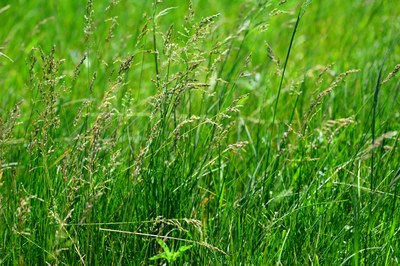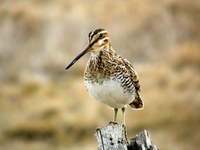Central Grasslands Forum: Fall 2017
A Walk Through the Pasture: News from CGREC
Kevin Sedivec, Interim Director – Central Grasslands Research Extension Center
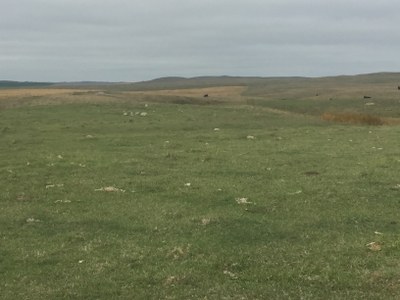 The summer and fall of 2017 was an exciting time for the Central Grasslands Research Extension Center (at least in my opinion). Like much of North Dakota, we experienced drought conditions; however, we were fortunate to receive moisture in June to grow grass in the new research trials and a good cool-season hay crop.
The summer and fall of 2017 was an exciting time for the Central Grasslands Research Extension Center (at least in my opinion). Like much of North Dakota, we experienced drought conditions; however, we were fortunate to receive moisture in June to grow grass in the new research trials and a good cool-season hay crop.
We were extremely dry in July, with our silage corn and Michael Undi’s grain corn used in the corn/cover crop study looking like a failure. However, once again the rains came, albeit for only four weeks, so our silage corn was very good and Undi was able to obtain data from the grain corn crop. We have been very dry since early September, receiving only 44 percent of average precipitation in the last two months.
All the new range research studies were started and 15 prescribed burns were conducted in May and August. One of the main focuses for the large patch burn/graze project is to study the impact on Kentucky bluegrass-invaded pastures.
Kentucky bluegrass, a non-native grass, is now our dominant grass in the Coteau Region, reducing diversity of native grasses and forbs, and subsequently reducing the value of these grasslands for pollinators and birds. As bluegrass increases, forage production declines, especially in times of drought, and long-term sustainability of our grassland is lost.
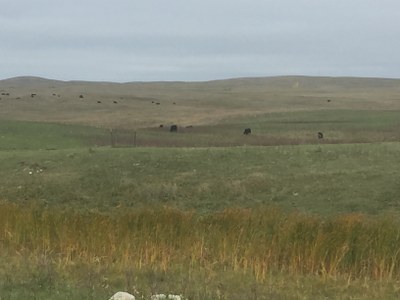 Our objective is for the patch burns to attract grazing cattle, severely disturbing the burned patch while lightly grazing the unburned areas. As you can see from the lower photo, we were successful in achieving this objective. The front of the pasture shows where the burn was and the back shows a high level of maturing grass where no burning occurred.
Our objective is for the patch burns to attract grazing cattle, severely disturbing the burned patch while lightly grazing the unburned areas. As you can see from the lower photo, we were successful in achieving this objective. The front of the pasture shows where the burn was and the back shows a high level of maturing grass where no burning occurred.
The question is: “What will happen to the heavily disturbed plant community?” We will see some results in 2018, but more likely, we’ll see a landscape impact once we finish the first rotation of the burn and grazing treatments after four years.
We had a successful year in conducting the livestock studies. The cows and calves came off pasture healthy, with the cows gaining 150 to 200 pounds during the summer. We had some calves come off pasture weighing more than 800 pounds (we calve from late March to early May).
I believe some of the high performance was a function of fresh water, which was provided to all grazing animals. Calves on fresh water can gain as much as 1/3 pound per day more than calves watering out of dugouts and wetlands.
Calves also gain more weight on pasture during droughty conditions. Drought-affected grass tends to cure better and contain less water. Thus, the forage is less “washy” and denser in nutrients.
Our research this fall and early winter will focus on late-season grazing experiments lead by Undi and his team of Stephanie Becker and Jessalyn Bachler. Lauren Hulsman Hanna will be completing her second year of a genetics study looking at calf behavior.
In closing, the snows and blues (geese) have arrived and Lake George is attracting tens of thousands of birds. The grouse are grouping for the winter, and deer hunting season is just around the corner. The landscape has turned from green to brown, with forage quality reduced, and cows are grazing crop residues (and bales in the bale grazing study) until they go to their wintering pastures.
Until our next walk through the pasture, enjoy the splendors that fall brings the Dakotas. Prepare your family (and livestock) for winter. Take time to enjoy your family, take a walk (or ride a horse), or enjoy a hunting trip with your son or daughter (or grandson and granddaughter) through North Dakota’s beautiful prairies.
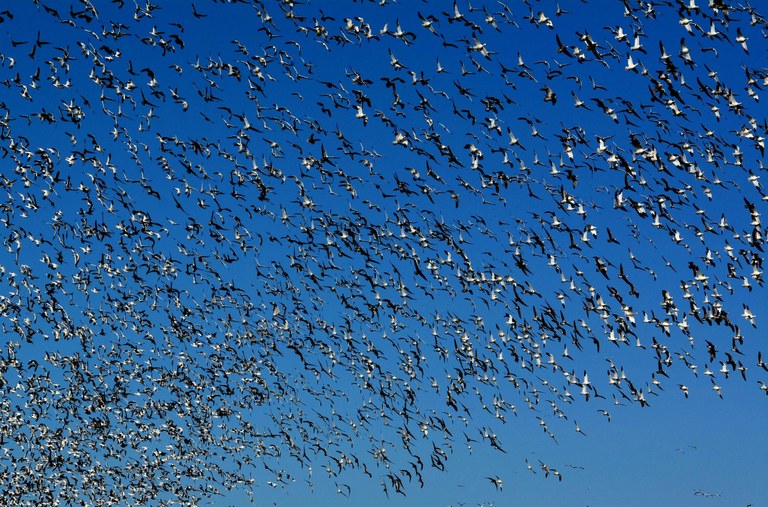
Photos by Kevin Sedivec and Rick Bohn, CGREC
Range Health and Plant Diversity, and Their Roles in Plant Community Function
David Toledo, PhD., Range Scientist, U.S. Department of Agriculture-Agricultural Research Station, Mandan, N.D.
Rangeland health refers to how well an ecosystem is functioning. This includes the interaction of soils, water, air and living organisms.
These organisms, and more specifically, the diversity of plants, play a key role in maintaining the function and productivity of an ecosystem. The nature and magnitude of the contribution that each individual plant species makes to the overall function of an ecosystem varies and is hard to quantify. However, research and experience has shown that maintaining plant diversity is key to maintaining ecosystem function.
In terms of productivity, research has shown that diversity can have an effect on the quantity and quality of the plant material produced. In forage-based livestock production systems, diversity is one of the main factors explaining plant productivity.
Maintaining high levels of biodiversity also provides the variety of forage that livestock will need throughout the year. Maintaining this diversity increases the resistance of livestock production systems to perturbations and decreases their vulnerability to extreme weather events such as drought.
In many parts of North Dakota, including the Missouri Coteau, maintaining plant biodiversity can be a challenge, mainly due to Kentucky bluegrass, a very successful grass species that was not originally part of Northern Great Plains ecosystems. The invasion and expansion of Kentucky bluegrass in this region has contributed to a decrease in native prairie plant species and has altered plant community structure and function.Kentucky bluegrass has contributed to declines in rangeland health due to changes in the soil/root structure (with shallow, dense roots), an increase in litter cover and changes in hydrology. However, this grass can have positive impacts on maintaining soil stability and also can serve as an important source of livestock forage during certain times of the year.
Data from the NDSU Central Grasslands Research Extension Center and the USDA-ARS Northern Great Plains Research Laboratory show that from the mid-1980s to today, Kentucky bluegrass increased from trace amounts to more than 80 percent frequency of occurrence in many pastures (Figure 1). Being a cool-season grass, this means that during hot, dry times of the year or in years with exceptional droughts like the one in 2017, the portions of pastures dominated by bluegrass were very unproductive.
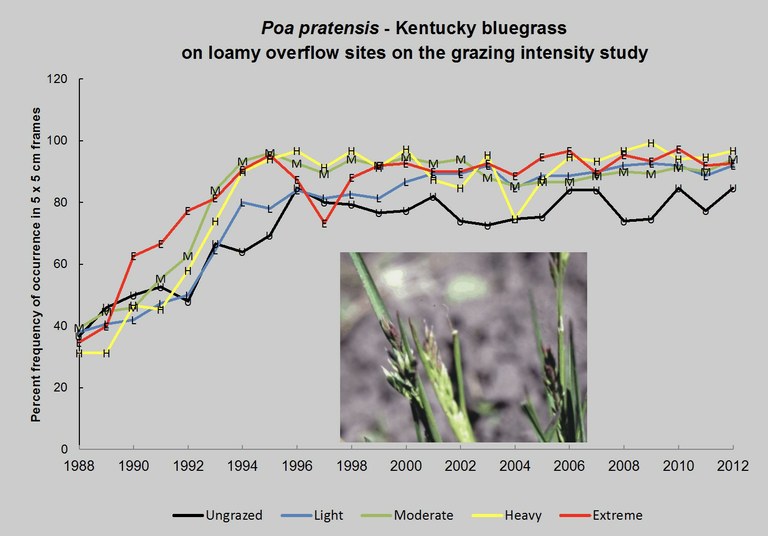
Figure 1. Percent of frequency of occurrence of Kentucky bluegrass on loamy overflow sites at the NDSU Central Grasslands Research Extension Center. Patton and Nyren (2012) Long-term grazing intensity research in the Missouri Coteau of North Dakota - 2012 Annual Report (see Table 9).
In terms of expanding our possibilities to adapt to change and apply precautionary measures, maintaining the suite of native forage species that are adapted to site-specific conditions likely will yield the greatest long-term benefits in terms of livestock production and the sustainability of the rangelands in which these livestock graze.
Many ongoing experiments throughout the state are aimed at addressing best management practices to increase plant diversity and improve livestock management operations. These include studies at the NDSU Central Grasslands REC, Hettinger REC and USDA-ARS.
The 2016 NDSU Central Grasslands REC annual report highlights one of these efforts. This report describes the use of early intensive and patch-burn grazing to control bluegrass and increase forage quality and production.
Photos by Rick Bohn, CGREC
 Honolulu Cookies
Honolulu Cookies
From the kitchen of Sandi Dewald, CGREC Administrative Secretary
2 eggs
1 c. shortening
1 c. white sugar
1 c. brown sugar
2 tsp. vanilla
1 tsp. soda
1 tsp. baking powder
¾ tsp. salt
2 c. flour – spooned into cup
2 c. quick-cooking oatmeal – spooned into cup
2 c. Rice Krispies
1 c. shelled sunflower seeds
¾ - 1 c. shredded coconut
Beat eggs, then add shortening, sugars, salt, soda, baking powder and vanilla and mix well. Hand stir in flour, oatmeal, Rice Krispies, sunflower seeds and coconut. Dough will be quite stiff. Drop by teaspoonfuls onto a greased baking sheet and flatten a bit. Bake in a 350°F oven for 9-10 minutes. These cookies are best not overbaked. If they brown, they will become hard.
Reasons to Test Forage and Notes on Feeding High-nitrate Feeds
Crystal Schaunaman, Extension Agent/McIntosh County
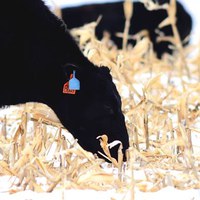 If your hay supply is short, as it is for many in our area, you probably are planning to use some questionable feedstuffs and/or will need to be very efficient this winter.
If your hay supply is short, as it is for many in our area, you probably are planning to use some questionable feedstuffs and/or will need to be very efficient this winter.
Forage testing will be extremely helpful to address these areas. Finding the line between feeding what you have and filling in the gaps with supplements is easier than you think. Forage test results can be put into Cowbytes (ration-balancing software) by your local Extension agent and diets can be explored for all classes of beef.
Manipulating the amount of forage and supplements will give you a cost per head per day so you can determine the most cost-effective way to feed this winter. It also can tell you what percent of high-nitrate feed you can include safely in the ration if you have that available.
If you baled your small-grain crops this summer, planning to use them without a forage test would be a big gamble. Having them analyzed will allow you to calculate how to include them safely in your ration and/or give you a reason to be more vigilant when turning cows out to graze the regrowth.
Ruminant animals, such as cattle and sheep, are susceptible to nitrate poisoning because their digestive process converts nitrate to nitrite, which in turn is converted to ammonia. The majority of nitrate poisoning cases in North Dakota occur with drought-stressed oats, corn and barley. However, a number of other plants also can accumulate nitrate, including wheat, sudangrass, sorghum-sudan hybrids, pearl millet and many common weeds.
I have had the opportunity to work with producers in sending in a variety of samples for testing this summer and fall. The nitrate levels in the results have been variable, from extremely low to off the chart.
Tests are very inexpensive, and as long as you do a good job when taking the sample, the results are very much worth your time. Your local Extension office has sampling forms, bags and postage-paid envelopes for several labs, as well as a bale probe to make the sampling process fast and easy.
The best way to prevent nitrate poisoning is controlling the type and quantity of forage. Avoid forages with potentially toxic levels until you have nitrate level results from a forage sample so you can dilute the forages with feeds low in nitrate. When grazing, feed dry roughage first to reduce the amount of nitrate-affected plants that the hungry animals will consume.
A few other tips are:
- Gradually introduce suspected forage into the ration during a period of one to two weeks, and don't feed it to hungry animals.
- Feed a well-balanced ration with proper nutrient content, proportion of forage dry matter and particle size.
- Discontinue or severely restrict the intake of suspected materials when you observe nitrate-poisoning symptoms.
Clinical signs of nitrate poisoning are related to the lack of oxygen in the blood. Acute poisoning usually occurs from a half-hour to four hours after consuming toxic levels of nitrate. The onset of symptoms is rapid. Those symptoms include:
* Bluish/chocolate brown mucous membranes
* Rapid/difficult or noisy breathing
* Rapid pulse (150-plus beats per minute)
* Salivation, bloat, tremors, staggering
* Dark “chocolate-colored” blood
* Weakness, coma, death
A publication from the NDSU Extension service, “Nitrate Poisoning of Livestock,” is available online: http://tinyurl.com/NitratePoisoning.
If you have any questions or want more information, call me at 701-288-5180 or stop by the Extension office.
Photo by Rick Bohn
Central Grasslands Forum - Fall 2017



